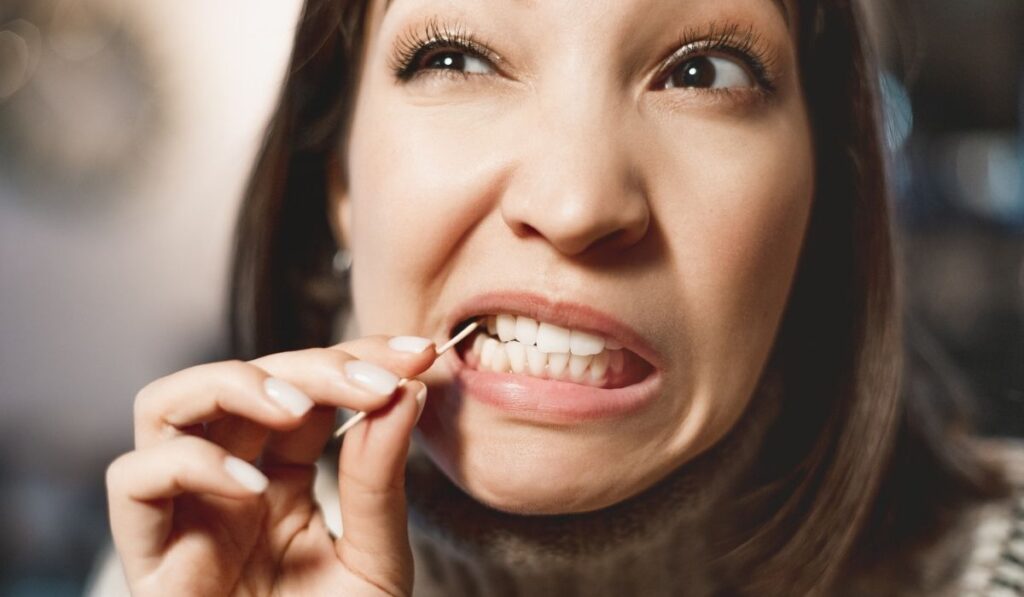Toothpicks exist across cultures and are probably the oldest dental instrument that we still use today. Toothpicks certainly are convenient, but people tend to overlook the risks that come with their use. It’s better to leave these primitive tools speared into cheese cubes and cocktail olives where they belong if you’re not going to be careful with them.
Toothpicks are bad for your teeth. They can wear out tooth enamel and cause sensitive, bleeding, and swollen gums. There is also a risk of gum laceration and infections from toothpick use. Instead of toothpicks, use dental floss or a Waterpik to remove food bits from your teeth.
Dentists have been warning against the use of toothpicks for years. As we mentioned, this seemingly harmless little stick has been linked to a slew of serious dental issues. So if you’re still using toothpicks at the end of your meals, it’s time to consider your other options for cleaning between teeth. Let’s explore some of the reasons toothpicks are so bad for your teeth.
What Are the Risks of Using Toothpicks?

Every time you stick a common toothpick (example on Amazon) in your mouth, you’re picking at the most vulnerable part of your tissue. Continual toothpick usage can undoubtedly lead to periodontal and oral infections or permanently damaged teeth. How? Let’s take a look.
- Toothpicks can weaken teeth roots: When you vigorously rub the toothpick between your teeth, you are essentially loosening a tooth’s attachment to the surrounding bone, which can cause gum recession, bone loss, and wiggly teeth. Overtime, this can result in gaps between the teeth and weaken their foundation.
- Toothpicks can lacerate gums: The sharp point at the end of the toothpick leaves small, open tears in the gums that can catch bacteria and lead to severe infections like gingivitis, especially if you have an underlying condition such as diabetes.
- Toothpicks can erode a tooth’s enamel: Enamel is a hard surface, but repeated chafing by the toothpick, especially one with a brushy end, can wear it away. You end up with exposed dentin that’s sensitive and susceptible to cavities.
- Toothpick can damage dental work: If you have a dental filling or crown, the toothpick can dislodge it.
- Toothpicks can introduce harmful germs to your mouth: It is very much possible that the toothpick you’re using is not properly sanitized. It could have picked up germs anywhere between its manufacture and the moment it enters your mouth.
If not addressed, these small but significant risks can turn into major dental issues. So keep your teeth safe and reach for dental floss whenever you need to clean in between your teeth. Just remember that a toothpick is never the best solution.
How Often Does Food Get Stuck in Your Teeth?
Chances are there’s a food that comes to mind when you think of things that get stuck in your teeth. Sesame seeds? Spinach? Popcorn kernels? Well, it’s completely normal for food to get stuck.
But if it’s happening too often and you get food stuck between your teeth after every meal, you may want to see your dentist. This can happen when the gap between teeth gets too big, and every bite just fills the spaces with food. Large gaps and accumulated food bits can eventually lead to hard tartar and cavities.
Toothpicks, however, just widen these gaps and cause more harm than good. So even if you’re getting irritated with all the stuck food, toothpicks are still not worth it. Instead, look for a safe solution like dental floss, and your dentist may also recommend composite bonding treatment for severe cases.
How to Safely Remove Stuck Food From Teeth

Regular flossing has been proven to be the most effective method for maintaining good oral health and preventing tooth decay and gum disease. So, if you want clean, pearly white, healthy teeth, flossing is by far the best solution for removing food bits without damaging teeth or gums.
If you’re confused about which floss to choose, you can try one of our recommendations:
Estrella Naturals Activated Charcoal Dental Floss (on Amazon): For those looking for all-natural floss, this product contains no artificial dyes or preservatives and has zero fluorides. The reviewers on Amazon love the minty flavor and activated charcoal coating that leaves their mouths fresh and clean.
PUL Pick Me Biodegradable Dental Floss Picks (on Amazon): Made with vegan, non-GMO material, these floss picks are perfect for picking out food bits after every meal. They’re also 100% eco-friendly and do not contain any plastic or synthetic fibers, so you can enjoy clean teeth without worrying about harming our planet.
For lasting results, floss at least once a day, and aim for proper dental flossing techniques.
How Should I Floss My Teeth?
Here’s the basic technique for proper flossing:
- Take a piece of floss that’s about the length between your finger tips and your elbows and wind most of it around one of your middle fingers, then wind the remaining floss around the same finger of the opposite hand.
- Use your index fingers and thumbs to hold the floss tightly. Make sure it’s taut but not so tight that it cuts into your gums.
- Guide the floss between each pair of teeth in a gentle up and down motion.
- When the floss reaches the gum line, curve it into a C shape against one of your teeth.
- Holding the floss, gently scrape the side of the tooth, moving it away from the gum line.
- Repeat on the other side of the gap and then move on to the next space.


